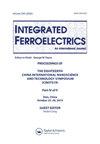Output Behavior of Fall Detection Sensor Using Brush-Based Triboelectric Nanogenerator Depending on Fiber Characteristics
IF 0.7
4区 工程技术
Q4 ENGINEERING, ELECTRICAL & ELECTRONIC
引用次数: 0
Abstract
Abstract In Japan, a huge portion of the population is aged people, who are prone to various diseases and injuries on a regular basis. Injuries due to falls are one of the biggest risk factors. Consequently, the demand for fall detection sensors, especially the ones that used a triboelectric nanogenerator (TENG) has recently increased. In a previous study, our group reported the development of a wearable sensor for fall detection with privacy protection using the principle of TENG. Conventional TENGs use polymer films as friction material. However, it is difficult for film-based TENGs to harvest output from various angles of contact separation, as the films have two-dimension structures. Consequently, our previous study focused on developing brush-based TENG (B-TENG), and B-TENG harvested output from various angles of contact-separation. However, the B-TENGs we developed were not sensitive enough to detect signals of lower contact force, and thereby could not be used in fall detection sensors. In this study, we focused on improving the performance of B-TENG by investigating the properties of the brushes and the effect of various external parameters on the harvested output voltage of B-TENGs. Consequently, we have constructed an optimized B-TENG, which harvests almost 18 times higher output voltage than the previous one developed by our group. Thus, this optimized B-TENG has the potential for practical use in fall detection sensors.基于刷基摩擦纳米发电机的跌落检测传感器输出特性与纤维特性的关系
在日本,很大一部分人口是老年人,他们经常容易患上各种疾病和受伤。摔伤是最大的危险因素之一。因此,对跌倒检测传感器的需求,特别是使用摩擦电纳米发电机(TENG)的传感器的需求最近有所增加。在之前的一项研究中,我们小组报告了一种可穿戴传感器的开发,该传感器用于使用TENG原理进行跌倒检测,并具有隐私保护。传统的teng使用聚合物薄膜作为摩擦材料。然而,由于薄膜具有二维结构,基于薄膜的teng很难从不同的接触分离角度获得输出。因此,我们之前的研究重点是开发基于刷子的TENG (B-TENG), B-TENG从不同的接触分离角度收获输出。然而,我们开发的b - teng不够灵敏,无法检测较低接触力的信号,因此不能用于跌倒检测传感器。在这项研究中,我们通过研究电刷的特性和各种外部参数对B-TENG输出电压的影响,重点研究了B-TENG的性能。因此,我们构建了一个优化的B-TENG,其输出电压几乎是我们小组之前开发的输出电压的18倍。因此,这种优化的B-TENG在跌倒检测传感器中具有实际应用的潜力。
本文章由计算机程序翻译,如有差异,请以英文原文为准。
求助全文
约1分钟内获得全文
求助全文
来源期刊

Integrated Ferroelectrics
工程技术-工程:电子与电气
CiteScore
1.40
自引率
0.00%
发文量
179
审稿时长
3 months
期刊介绍:
Integrated Ferroelectrics provides an international, interdisciplinary forum for electronic engineers and physicists as well as process and systems engineers, ceramicists, and chemists who are involved in research, design, development, manufacturing and utilization of integrated ferroelectric devices. Such devices unite ferroelectric films and semiconductor integrated circuit chips. The result is a new family of electronic devices, which combine the unique nonvolatile memory, pyroelectric, piezoelectric, photorefractive, radiation-hard, acoustic and/or dielectric properties of ferroelectric materials with the dynamic memory, logic and/or amplification properties and miniaturization and low-cost advantages of semiconductor i.c. technology.
 求助内容:
求助内容: 应助结果提醒方式:
应助结果提醒方式:


